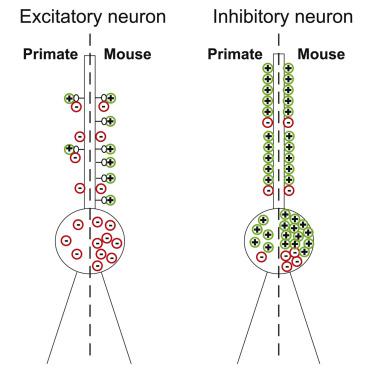Cell Reports ( IF 8.8 ) Pub Date : 2021-09-14 , DOI: 10.1016/j.celrep.2021.109709 Gregg A Wildenberg 1 , Matt R Rosen 2 , Jack Lundell 2 , Dawn Paukner 2 , David J Freedman 2 , Narayanan Kasthuri 1

|
Detailing how primate and mouse neurons differ is critical for creating generalized models of how neurons process information. We reconstruct 15,748 synapses in adult Rhesus macaques and mice and ask how connectivity differs on identified cell types in layer 2/3 of primary visual cortex. Primate excitatory and inhibitory neurons receive 2–5 times fewer excitatory and inhibitory synapses than similar mouse neurons. Primate excitatory neurons have lower excitatory-to-inhibitory (E/I) ratios than mouse but similar E/I ratios in inhibitory neurons. In both species, properties of inhibitory axons such as synapse size and frequency are unchanged, and inhibitory innervation of excitatory neurons is local and specific. Using artificial recurrent neural networks (RNNs) optimized for different cognitive tasks, we find that penalizing networks for creating and maintaining synapses, as opposed to neuronal firing, reduces the number of connections per node as the number of nodes increases, similar to primate neurons compared with mice.
中文翻译:

与小鼠相比,灵长类动物的皮层神经元连接稀疏
详细说明灵长类动物和小鼠神经元的差异对于创建神经元如何处理信息的通用模型至关重要。我们重建成年恒河猴和小鼠的 15,748 个突触,并询问初级视觉皮层 2/3 层中已识别细胞类型的连接性有何不同。灵长类动物兴奋性和抑制性神经元接受的兴奋性和抑制性突触比类似的小鼠神经元少 2-5 倍。灵长类动物兴奋性神经元的兴奋性与抑制性 (E/I) 比率低于小鼠,但抑制性神经元的 E/I 比率相似。在这两个物种中,抑制性轴突的特性,如突触大小和频率都没有改变,兴奋性神经元的抑制性神经支配是局部的和特异性的。使用针对不同认知任务优化的人工循环神经网络 (RNN),

























 京公网安备 11010802027423号
京公网安备 11010802027423号